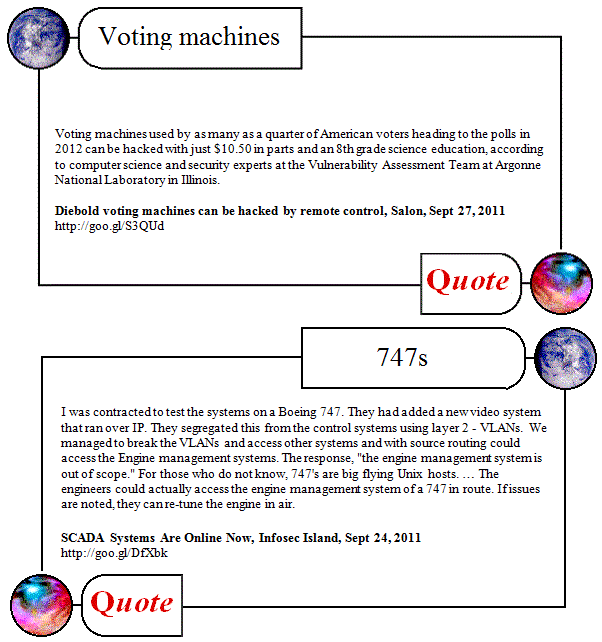But though they may hate the Pax Americana, the Greens probably can’t live without it. Can’t live without the Ipods, the connectivity, the store-bought food, the cafe-bought lattes — all the ugly things made by private industry. And by paring down the redundancies in the system as wasteful and unsightly; by reducing the energy reserves of the system in favor of such fairy schemes as windmills and carbon trading the Greens have made the system far less robust than it could have been. Because they are never going to need the Design Margin. Ever. Until they do.
Systems Analysis
Estimating Odds
From a comment by “Eggplant” at Belmont Club:
Supposedly the US has war gamed this thing and the prospects look poor. A war game is only as good as the assumptions programmed into it. Can the war game be programmed to consider the possibility that a single Iranian leader has access to an ex-Soviet nuke and is crazed enough to use it?
Of course the answer is “No Way”.
A valid war game would be a Monte Carlo simulation that considered a range of possible scenarios. However the tails of that Gaussian distribution would offer extremely frightening scenarios. The Israelis are in the situation where truly catastrophic scenarios have tiny probability but the expectation value [consequence times probability] is still horrific. However “fortune favors the brave”. Also being the driver of events is almost always better than passively waiting and hoping for a miracle. That last argument means the Israelis will launch an attack and probably before the American election.
These are important points. The outcomes of simulations, including the results of focus groups used in business and political marketing, may be path-dependent. If they are the results of any one simulation may be misleading and it may be tempting to game the starting assumptions in order to nudge the output in the direction you want. It is much better if you can run many simulations using a wide range of inputs. Then you can say something like: We ran 100 simulations using the parameter ranges specified below and found that the results converged on X in 83 percent of the cases. Or: We ran 100 simulations and found no clear pattern in the results as long as Parameter Y was in the range 20-80. And by the way, here are the data. We don’t know the structure of the leaked US simulation of an Israeli attack on Iran and its aftermath.
It’s also true, as Eggplant points out, that the Israelis have to consider outlier possibilities that may be highly unlikely but would be catastrophic if they came to pass. These are possibilities that might show up only a few times or not at all in the output of a hypothetical 100-run Monte Carlo simulation. But such possibilities must still be taken into account because 1) they are theoretically possible and sufficiently bad that they cannot be allowed to happen under any circumstances and 2) the simulation-based probabilities may be inaccurate due to errors in assumptions.
“Statistical Quality Control Meets the NYPD”
An excellent post by Mark Draughn that reminds how we get the behavior we incentivize. In this case the NYC govt incentivized its police to ignore violent crimes and to make bogus arrests to boost their cleared-case stats:
This is a standard recipe for disaster in quality control — and CompStat is at heart a statistical quality control program. Take a bunch of people doing a job, make them report quality control data, and put pressure on them to produce good numbers. If there is little oversight and lots of pressure, then good numbers is exactly what they’ll give you. Even if they’re not true.
Worth reading in full.
Adventure

Many people canoe and kayak in the Florida Everglades’ extensive inland waterways, which are beautiful, full of interesting plants and animals and easily accessible. I couldn’t refuse an invitation to join friends for a day trip down the Turner River in the Big Cypress area. My friends arranged for me to borrow a kayak but its owner backed out of the trip at the last minute. Fortunately, the guy who organized the trip offered me the use of a kayak that he owns.
Mapping our interdependencies and vulnerabilities [with a glance at Y2K]
[ cross-posted from Zenpundit — mapping, silos, Y2K, 9/11, rumors, wars, Boeing 747s, Diebold voting machines, vulnerabilities, dependencies ]
The “bug” of Y2K never quite measured up to the 1919 influenza bug in terms of devastating effect — but as TPM Barnett wrote in The Pentagon’s New Map:
Whether Y2K turned out to be nothing or a complete disaster was less important, research-wise, than the thinking we pursued as we tried to imagine – in advance – what a terrible shock to the system would do to the United States and the world in this day and age.
1.
My own personal preoccupations during the run-up to Y2K had to do with cults, militias and terrorists — any one of which might have tried for a spectacle.
As it turned out, though, Al Qaida’s plan to set off a bomb at Los Angeles International Airport on New Year’s Eve, 1999 was foiled when Albert Ressam was arrested attempting to enter the US from Canada — so that aspect of what might have happened during the roll-over was essentially postponed until September 11, 2001. And the leaders of the Ugandan Movement for the Restoration of the Ten Commandments of God, acting on visionary instructions (allegedly) from the Virgin Mary, announced that the end of the world had been postponed from Dec 31 / Jan 1 till March 17 — at which point they burned 500 of their members to death in their locked church. So that apocalyptic possibility, too, was temporarily averted.
2.
Don Beck of the National Values Center / The Spiral Dynamics Group, commented to me at one point in the run-up:
Y2K is like a lightening bolt: when it strikes and lights up the sky, we will see the contours of our social systems.
— and that quote from Beck, along with Barnett’s observation, pointed strongly to the fact that we don’t have anything remotely resembling a decent global map of interdependencies and vulnerabilities.
What we have instead is a PERT chart for this or that, Markov diagrams, social network maps, railroad maps and timetables… oodles and oodles of smaller pieces of the puzzle of past, present and future… each with its own symbol system and limited scope. Our mapping, in other words, is territorialized, siloed, and disconnected, while the world system which is integral to our being and survival is connected, indeed, seamlessly interwoven.
I’ve suggested before now that our mapping needs to pass across the Cartesian divide from the objective to the subjective, from materiel to morale, from the quantitative to the qualitative, and from rumors to wars. It also needs a uniform language or translation service, so that Jay Forrester system dynamic models can “talk” with PERT and Markov and the rest, Bucky Fuller‘s World Game included.
I suppose some of all this is ongoing, somewhere behind impenetrable curtains, but I wonder how much.
3.
In the meantime, and working from open source materials, the only kind to which I have access – here are two data points we might have noted a litle earlier, if we had decent interdependency and vulnerability mapping:
Fear-mongering — or significant alerts? I’m not tech savvy enough to know.
4.
Tom Barnett’s point about “the thinking we pursued as we tried to imagine – in advance – what a terrible shock to the system would do to the United States and the world in this day and age” still stands.
Y2K was what first alerted me to the significance of SCADAs.
Something very like what Y2K might have been seems to be unfolding — but slowly, slowly.
Are we thinking yet?

